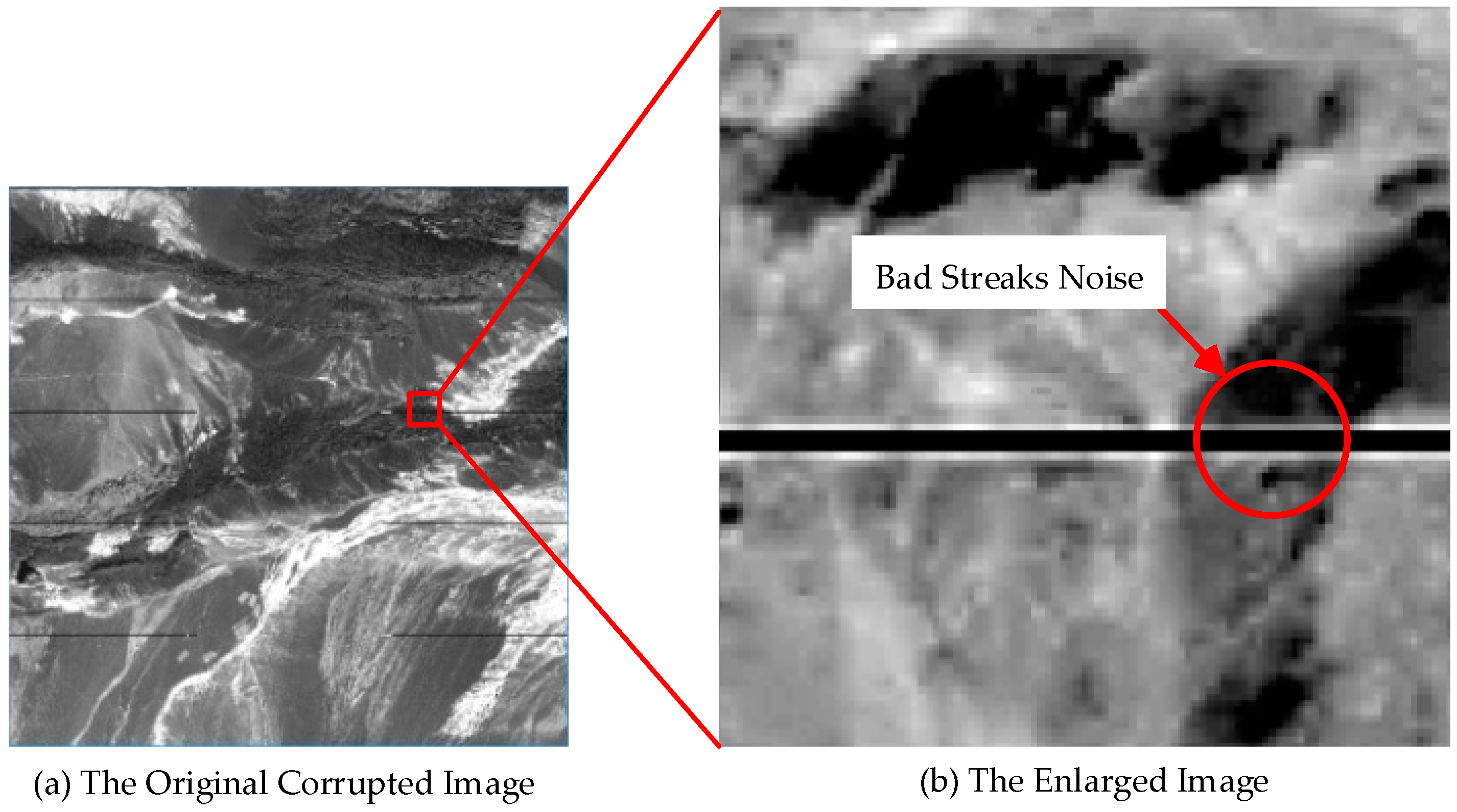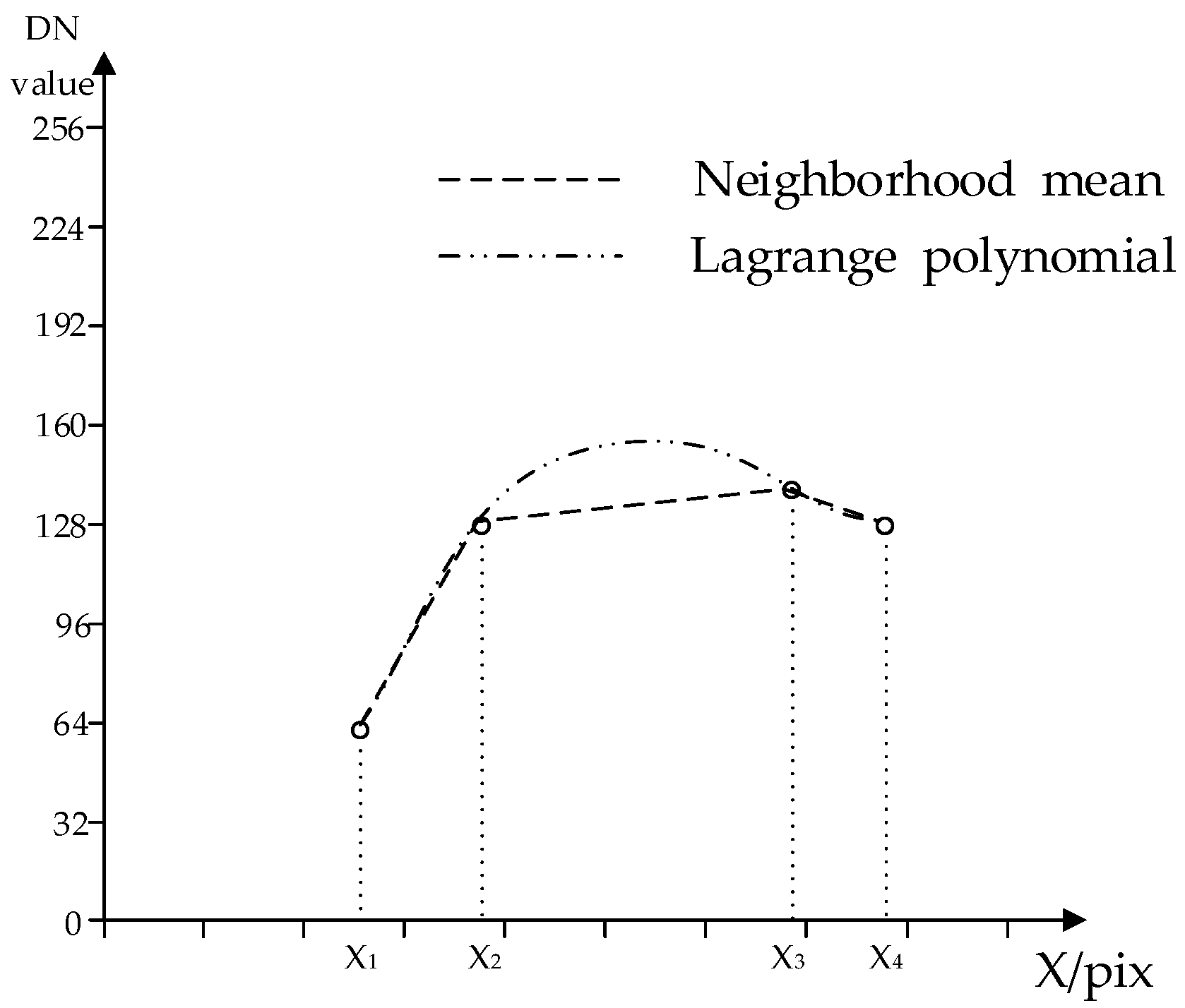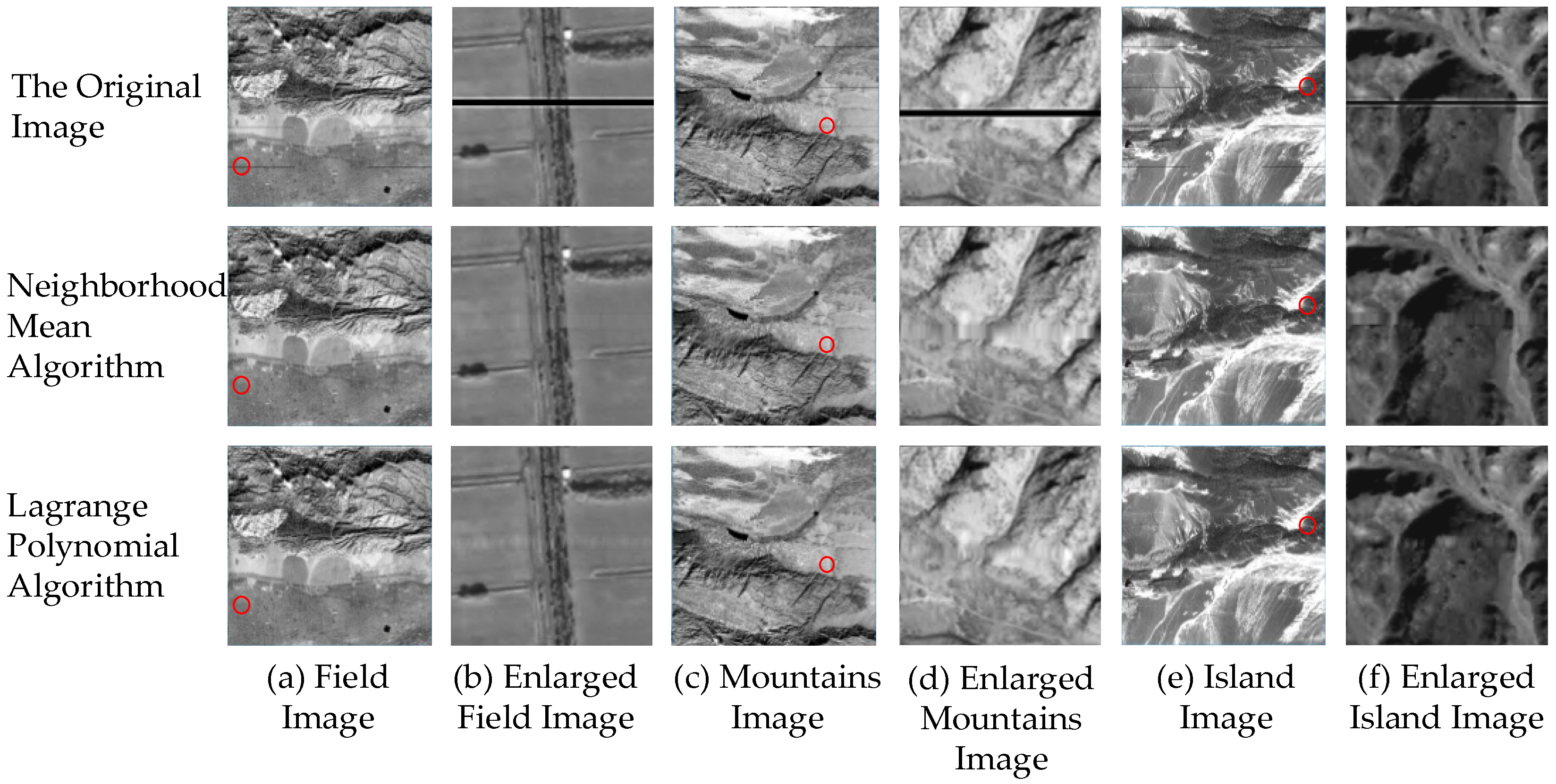Improved Line Tracing Methods for Removal of Bad Streaks Noise in CCD Line Array Image—A Case Study with GF-1 Images
Abstract
:1. Introduction
2. Data
3. Methods
3.1. Line Tracing Method
3.2. Lagrange Polynomial Algorithm
3.3. Validation
4. Results
4.1. Results of Line Tracing Method
4.2. Results of Lagrange Polynomial Algorithm
5. Discussion
6. Conclusions
Acknowledgments
Author Contributions
Conflicts of Interest
References
- Zhu, L.; Li, Y.M.; Zhao, S.H. Remote sensing monitoring of Taihu Lake water quality by using GF-1 satellite WFV data. Remote Sens. Land Resour. 2015, 27, 113–120. [Google Scholar]
- Hu, B.; Zhou, Z.; Meng, Y.; Jiang, L. Destriping Model of MODIS Images Based on Moment Matching and Variational Approach. Infrared 2014, 35, 28–36. [Google Scholar]
- Srinivasan, R.; Cannon, M.; White, J. Landsat Data Destriping Using Power Spectral Filtering. Opt. Eng. 1988, 27, 939–943. [Google Scholar] [CrossRef]
- Kang, W.; Yu, S.; Seo, D.; Jeong, J.; Paik, J. Push-Broom-Type Very High-Resolution Satellite Sensor Data Correction Using Combined Wavelet-Fourier and Multiscale Non-Local Means Filtering. Sensors 2015, 15, 22826–22853. [Google Scholar] [CrossRef] [PubMed]
- Gadallah, F.L.; Csillag, F.; Smith, E.J.M. Destriping Multisensor Imagery with Moment Matching. Int. J. Remote Sens. 2000, 21, 2505–2511. [Google Scholar] [CrossRef]
- Ali, D.B.; Stefan, E.; Martin, K. Multi-Source Remotely Sensed Data Combination: Projection Transformation Gap-Fill Procedure Sensors. Sensors 2008, 8, 4429–4440. [Google Scholar]
- Sun, Y.; Jiang, L.; Liu, L. Surface flow velocity of mountain glaciers derived from Landsat-7 ETM+ SLC-OFF images: Extrac-tion and quantitative evaluation: A case study of the Siachen Glacier in the Karakoram. J. Glaciol. Geocryol. 2016, 38, 596–603. [Google Scholar]
- Zhu, C.; Shen, Z.; Luo, J. Research on Landsat-7 SLC -off Image Restoration Method Based on MODIS09 Data. Acta Geod. Cartogr. Sin. 2010, 39, 251–255. [Google Scholar]
- Hou, W.; Ma, J.; Bai, X. A Method Using Landsat TM to Fill Gapsin ETM+ SLC of Images. Remotes Sens. Inf. 2013, 28, 73–77. [Google Scholar]
- Shou, J.; Chen, X.; Ma, J. Application and Research on the Recovery of Landsat-7 SLC-off Images Based on ARL. J. Optoelectron. Laser 2006, 17, 368–371. [Google Scholar]
- Han, T.; Goodenough, D.G.; Dyk, A. Detection and Correction of Abnormal Pixels in Hyperion Images. In Proceedings of the IEEE International Geoscience & Remote Sensing Symposium, Toronto, ON, Canada, 24–28 June 2002; Volume 3, pp. 1327–1330. [Google Scholar]
- Goodenough, D.G.; Dyk, A.; Niemann, K.O. Processing Hyperion and ALI for Forest Classification. IEEE Trans. Geosci. Remote Sens. 2003, 41, 1321–1331. [Google Scholar] [CrossRef]
- Gao, H.; Gu, X.; Yu, T. Method Research on Destriping Hyperion Image Noise. Remote Sens. Inf. 2014, 29, 3–7. [Google Scholar]
- Zeng, C.; Shen, H.; Zhang, L. Recovering missing pixels for Landsat ETM + SLC-off imagery using multi-temporal regression analysis and a regularization method. Remote Sens. Environ. 2013, 131, 182–194. [Google Scholar] [CrossRef]
- Shen, Y.; Liu, X.; Wu, L. A Local Spectral-Spatial Similarity Measure (LS3M) for Bad Line Correction in Hyperion Hyperspectral Data. Geomat. Inform. Sci. Wuhan Univ. 2016, 25, 125–127. [Google Scholar]
- Tan, B.; Li, Z.; Chen, E. Preprocessing of EO-1 Hyperion Hyperspectral Data. Remote Sens. Inf. 2005, 6, 36–41. [Google Scholar]
- Chen, J.; Zhu, X.; Vogelmann, J.E. A simple and effective method for filling gaps in Landsat EMT plus SLC-off image. Remotes Sens. Environ. 2011, 115, 1053–1064. [Google Scholar] [CrossRef]
- Strong, C.; Golden, K.M. Filling the Polar Data Gap in Sea Ice Concentration Fields Using Partial Differential Equations. Remote Sens. 2016, 8, 442. [Google Scholar] [CrossRef]
- Fu, S.; Lou, S. Regional Texture Synthesis Based Image Inpainting. J. Electron. Inf. Technol. 2009, 31, 1319–1322. [Google Scholar]
- Zou, H.; Qin, X.; Zhou, S.; Ji, K. A Likelihood-Based SLIC Superpixel Algorithm for SAR Images Using Generalized Gamma Distribution. Sensors 2016, 16, 1107. [Google Scholar] [CrossRef] [PubMed]
- Yin, G.; Mariethoz, G.; McCabe, M.F. Gap-Filling of Landsat 7 Imagery Using the Direct Sampling Method. Remote Sens. 2017, 9, 12. [Google Scholar] [CrossRef]
- Maxwrll, S.K.; Schmidt, G.L.; Storey, J.C. A multi-scale segmentation approach to filling gaps in Landsat EMT + SLC-off images. Int. J. Remote Sens. 2007, 28, 5339–5956. [Google Scholar] [CrossRef]
- Yu, Y.; Fan, W.; Yang, X. Comparison Analysis of Bad Pixel Repair Methods for EO-1 Hyperion. J. Northeast For. Univ. 2009, 37, 123–124. [Google Scholar]
- Lin, Y.; Bao, K. The Impact of the Scan Lines Corrector Malfunction on Landsat-7 Imagery Data and the Processing Methods. Remote Sens. Inf. 2005, 2, 33–35. [Google Scholar]
- Wijedasa, L.S.; Sloan, S.; Michelakis, D.G.; Clements, G.R. Overcoming Limitations with Landsat Imagery for Mapping of Peat Swamp Forests in Sundaland. Remote Sens. 2012, 4, 2595–2618. [Google Scholar] [CrossRef]
- Ding, C.; Feng, G.; Li, Z.; Shan, X.; Du, Y.; Wang, H. Spatio-Temporal Error Sources Analysis and Accuracy Improvement in Landsat 8 Image Ground Displacement Measurements. Remote Sens. 2016, 8, 937. [Google Scholar] [CrossRef]
- Fu, X.; Guo, X. Lagrange Average Interpolation Method. Nat. Sci. J. Hainan Univ. 2007, 25, 125–127. [Google Scholar]






| ID | Lat/Long | Terrain | Sensor | Image Size | Color Depth (bit) | Resolution (m) |
|---|---|---|---|---|---|---|
| a | 85.8/41.9 | Field | PAN | 18,192 × 18,000 | 16 | 2.0 |
| b | 85.8/42.2 | Mountains | PAN | 18,192 × 18,000 | 16 | 2.0 |
| c | 86.5/47.4 | Island | PAN | 18,192 × 18,000 | 16 | 2.0 |
| Method | The Number of Found | The Number of Not Found | The Number of Wrong |
|---|---|---|---|
| Traversal full map method | 352,277 | 2823 | 0 |
| Line tracing method | 352,925 | 2175 | 0 |
| Method | Time (s) |
|---|---|
| Traversal full map method | 61.1 |
| Line tracing method | 26.9 |
| Method | The Original Image | The Simulation Image | Neighborhood Mean Algorithm | Lagrange Polynomial Algorithm |
|---|---|---|---|---|
| Image Entropy | 6.2520 | 0 | 6.1839 | 6.2897 |
| Terrain | The Original Image | Neighborhood Mean Algorithm | Lagrange Polynomial Algorithm |
|---|---|---|---|
| Field | 5.6661 | 5.5858 | 5.6841 |
| Mountains | 8.0018 | 7.7176 | 8.0883 |
| Island | 6.8297 | 6.5766 | 6.9501 |
© 2017 by the authors. Licensee MDPI, Basel, Switzerland. This article is an open access article distributed under the terms and conditions of the Creative Commons Attribution (CC BY) license (http://creativecommons.org/licenses/by/4.0/).
Share and Cite
Wang, B.; Bao, J.; Wang, S.; Wang, H.; Sheng, Q. Improved Line Tracing Methods for Removal of Bad Streaks Noise in CCD Line Array Image—A Case Study with GF-1 Images. Sensors 2017, 17, 935. https://doi.org/10.3390/s17040935
Wang B, Bao J, Wang S, Wang H, Sheng Q. Improved Line Tracing Methods for Removal of Bad Streaks Noise in CCD Line Array Image—A Case Study with GF-1 Images. Sensors. 2017; 17(4):935. https://doi.org/10.3390/s17040935
Chicago/Turabian StyleWang, Bo, Jianwei Bao, Shikui Wang, Houjun Wang, and Qinghong Sheng. 2017. "Improved Line Tracing Methods for Removal of Bad Streaks Noise in CCD Line Array Image—A Case Study with GF-1 Images" Sensors 17, no. 4: 935. https://doi.org/10.3390/s17040935





